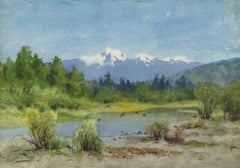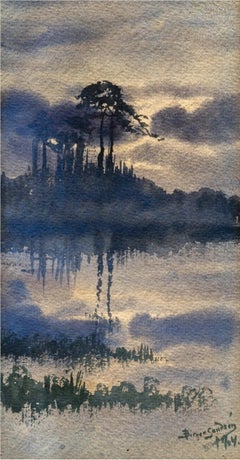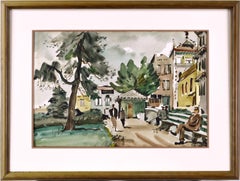Dong Kingman Paintings
American, Chinese, 1911-2000
Born in Oakland, CA on March 31, 1911. When Kingman was five, his family moved to Hong Kong where he grew up and attended Lingnan Grammar School. The headmaster of the school, Szetu Wei, had studied painting in Paris and recognized his budding artistic talent. For several years he trained young Kingman in both oriental and occidental approaches to painting. Returning to San Francisco in 1929, Kingman became active in the local art scene and began painting scenes of the city. His first solo show at the San Francisco Art Center in 1936 brought immediate recognition. During the 1930s he spent five years working on commissions for the Federal Public Works of Art Project. During WWII he created maps and charts for the O.S.S. After the war Kingman settled in NYC and taught at Columbia University. His paintings were used as backdrops for the movie "Flower Drum Song" and his watercolors were reproduced in Life and on the covers of Fortune and Holiday magazines. Kingman died in NYC on May 12, 2000. Member: American WC Society; NA (1951). Exh: SFMA Inaugural, 1935; Vallejo Public Library, 1935; Calif. WC Society, 1935-44; San Francisco Art Association, 1936 (1st prize); GGIE, 1939; San Diego FA Gallery, 1943; De Young Museum, 1945 (solo); County Fair (LA), 1949; Philadelphia WC Club, 1950 (medal); NAD, 1975 (gold medal). In: MM; SFMA; Boston Museum; Delaware Museum; Whitney Museum (NYC); MOMA; CHS; Brooklyn Museum; De Young Museum; San Diego Museum; Mills College (Oakland); AIC; NAD; Butler Art Inst. (Columbus, OH); Wilmington (DE) Society of FA; Toledo (OH) Museum; Dartmouth College; U.S. State Dept; Addison Gallery (Andover, MA); Evansville Museum.to
1
1
Overall Width
to
Overall Height
to
1
1
1
1
1
1
1
22
781
717
705
691
1
1
Artist: Dong Kingman
Acapulco Beach Scene, Impressionist Watercolor by Dong Kingman
By Dong Kingman
Located in Long Island City, NY
Artist: Dong Moy Chu Kingman, Chinese/American (1911 - 2000)
Title: Acapulco Beach Scene I
Year: 1968
Medium: Watercolor, signed and dated l.r.
Size: 10.5 x 18 on 13.5 x 20.5 inches
...
Category
1960s American Impressionist Dong Kingman Paintings
Materials
Watercolor
$2,360 Sale Price
20% Off
Related Items
Colorado Mountain Landscape with River, 1890s Watercolor Painting
By Charles Partridge Adams
Located in Denver, CO
This original late 19th-century watercolor painting beautifully captures a classic Colorado mountain landscape by iconic early 20th century artist, Charles Partridge Adams. The compo...
Category
1980s American Impressionist Dong Kingman Paintings
Materials
Watercolor
$2,450
H 15 in W 18.25 in D 0.75 in
Swedish Landscape 1904
By Birger Sandzen
Located in North Clarendon, VT
Striking watercolor of Sweden from 1904 exhibiting Birger Sandzén's characteristic style. Housed in a custom quarter sawn oak frame. Signed and dated lower right and catalogued at th...
Category
Early 1900s American Impressionist Dong Kingman Paintings
Materials
Watercolor
Charles Partridge Adams, Colorado Landscape Gouache, 20th-Century Plein Air Art
By Charles Partridge Adams
Located in Denver, CO
This original circa 1910s plein air field study by celebrated Colorado landscape painter Charles Partridge Adams (1858–1942) beautifully captures the tranquil majesty of the Rocky Mo...
Category
1910s American Impressionist Dong Kingman Paintings
Materials
Gouache
$1,880
H 13.75 in W 17.75 in D 0.75 in
METCALF American Impressionist Landscape Watercolor
By Willard LeRoy Metcalf
Located in New York, NY
Willard Metcalf (1858-1925) was an important American Impressionist, member of the American Watercolor Society, and teaching at Cooper Union and the Art Student's League.
This comp...
Category
Early 20th Century American Impressionist Dong Kingman Paintings
Materials
Watercolor
$2,800
H 17.5 in W 23.5 in
Six Guns
By Henry Ives Cobb, Jr.
Located in North Clarendon, VT
Fantastic New York Central Park scene by Henry Ives Cobb Jr. Signed lower left. Gouache on paper. Titled "Six Gun".
Henry Ives Cobb Jr. (March 24, 1883 – August 1974) was an America...
Category
1940s American Impressionist Dong Kingman Paintings
Materials
Gouache
Looking West from Richmond Hill, Port Antonio, Jamaica
By Philip Little
Located in North Clarendon, VT
Fantastic Philip Little watercolor of Jamaica from 1922. Watercolor paper mounted on board, signed and dated lower right.
Philip Little was a prominent Salem, Massachusetts, artist ...
Category
1920s American Impressionist Dong Kingman Paintings
Materials
Watercolor
Maine Coastal Landscape by E.W. Kingsbury, c. 1920s
Located in New York, NY
Edmund Winchester Kingsbury (American, 1862-1931)
Untitled (Maine Coast), c. 1920s
Watercolor on paper
Sight: 13 1/4 x 20 3/4 in.
Framed: 18 x 25 5/8 x 1 1/8 in.
Signed lower right: ...
Category
1920s American Impressionist Dong Kingman Paintings
Materials
Paper, Gouache
$600
H 18 in W 25.625 in D 1.125 in
"Train Station, " Max Kuehne, Industrial City Scene, American Impressionism
By Max Kuehne
Located in New York, NY
Max Kuehne (1880 - 1968)
Train Station, circa 1910
Watercolor on paper
8 1/4 x 10 1/4 inches
Signed lower right
Provenance:
Private Collection, Illinois
Max Kuehne was born in Halle, Germany on November 7, 1880. During his adolescence the family immigrated to America and settled in Flushing, New York. As a young man, Max was active in rowing events, bicycle racing, swimming and sailing. After experimenting with various occupations, Kuehne decided to study art, which led him to William Merritt Chase's famous school in New York; he was trained by Chase himself, then by Kenneth Hayes Miller. Chase was at the peak of his career, and his portraits were especially in demand. Kuehne would have profited from Chase's invaluable lessons in technique, as well as his inspirational personality. Miller, only four years older than Kuehne, was another of the many artists to benefit from Chase's teachings. Even though Miller still would have been under the spell of Chase upon Kuehne's arrival, he was already experimenting with an aestheticism that went beyond Chase's realism and virtuosity of the brush. Later Miller developed a style dependent upon volumetric figures that recall Italian Renaissance prototypes.
Kuehne moved from Miller to Robert Henri in 1909. Rockwell Kent, who also studied under Chase, Miller, and Henri, expressed what he felt were their respective contributions: "As Chase had taught us to use our eyes, and Henri to enlist our hearts, Miller called on us to use our heads." (Rockwell Kent, It's Me O Lord: The Autobiography of Rockwell Kent. New York: Dodd, Mead and Co., 1955, p. 83). Henri prompted Kuehne to search out the unvarnished realities of urban living; a notable portion of Henri's stylistic formula was incorporated into his work.
Having received such a thorough foundation in art, Kuehne spent a year in Europe's major art museums to study techniques of the old masters. His son Richard named Ernest Lawson as one of Max Kuehne's European traveling companions. In 1911 Kuehne moved to New York where he maintained a studio and painted everyday scenes around him, using the rather Manet-like, dark palette of Henri.
A trip to Gloucester during the following summer engendered a brighter palette. In the words of Gallatin (1924, p. 60), during that summer Kuehne "executed some of his most successful pictures, paintings full of sunlight . . . revealing the fact that he was becoming a colorist of considerable distinction." Kuehne was away in England the year of the Armory Show (1913), where he worked on powerful, painterly seascapes on the rocky shores of Cornwall. Possibly inspired by Henri - who had discovered Madrid in 1900 then took classes there in 1906, 1908 and 1912 - Kuehne visited Spain in 1914; in all, he would spend three years there, maintaining a studio in Granada. He developed his own impressionism and a greater simplicity while in Spain, under the influence of the brilliant Mediterranean light. George Bellows convinced Kuehne to spend the summer of 1919 in Rockport, Maine (near Camden). The influence of Bellows was more than casual; he would have intensified Kuehne's commitment to paint life "in the raw" around him.
After another brief trip to Spain in 1920, Kuehne went to the other Rockport (Cape Ann, Massachusetts) where he was accepted as a member of the vigorous art colony, spearheaded by Aldro T. Hibbard. Rockport's picturesque ambiance fulfilled the needs of an artist-sailor: as a writer in the Gloucester Daily Times explained, "Max Kuehne came to Rockport to paint, but he stayed to sail." The 1920s was a boom decade for Cape Ann, as it was for the rest of the nation. Kuehne's studio in Rockport was formerly occupied by Jonas Lie.
Kuehne spent the summer of 1923 in Paris, where in July, André Breton started a brawl as the curtain went up on a play by his rival Tristan Tzara; the event signified the demise of the Dada movement. Kuehne could not relate to this avant-garde art but was apparently influenced by more traditional painters — the Fauves, Nabis, and painters such as Bonnard. Gallatin perceived a looser handling and more brilliant color in the pictures Kuehne brought back to the States in the fall. In 1926, Kuehne won the First Honorable Mention at the Carnegie Institute, and he re-exhibited there, for example, in 1937 (Before the Wind). Besides painting, Kuehne did sculpture, decorative screens, and furniture work with carved and gilded molding. In addition, he designed and carved his own frames, and John Taylor Adams encouraged Kuehne to execute etchings. Through his talents in all these media he was able to survive the Depression, and during the 1940s and 1950s these activities almost eclipsed his easel painting. In later years, Kuehne's landscapes and still-lifes show the influence of Cézanne and Bonnard, and his style changed radically.
Max Kuehne died in 1968. He exhibited his work at the National Academy of Design, the Art Institute of Chicago, the Carnegie Institute in Pittsburgh, the Memorial Art Gallery of the University of Rochester, and in various New York City galleries. Kuehne's works are in the following public collections: the Detroit Institute of Arts (Marine Headland), the Whitney Museum (Diamond Hill...
Category
1910s American Impressionist Dong Kingman Paintings
Materials
Paper, Watercolor
$2,800 Sale Price
20% Off
H 13.5 in W 15.5 in
"Forest Landscape" John F. Carlson, circa 1925 American Impressionist Landscape
By John F. Carlson
Located in New York, NY
John F. Carlson
Forest Landscape, circa 1925
Signed lower right
Watercolor on paper
Sight 21 x 24 1/2 inches
The native Swede John Fabian Carlson became a household name in New Yor...
Category
1920s American Impressionist Dong Kingman Paintings
Materials
Paper, Watercolor
1950s Denver Skyline Painting – Graphite & Watercolor Colorado Cityscape Art
Located in Denver, CO
A captivating midcentury cityscape titled "Denver Skyline", this original 1950s watercolor and graphite painting offers a rare industrial-era view of lower downtown Denver, Colorado....
Category
1950s American Impressionist Dong Kingman Paintings
Materials
Watercolor, Graphite
$1,950
H 17.5 in W 21.5 in D 0.75 in
Charles Partridge Adams Watercolor – New Hampshire Mill Scene, c. 1900
By Charles Partridge Adams
Located in Denver, CO
This elegant original watercolor painting by renowned landscape artist Charles Partridge Adams (1858–1942) was created circa 1900 and captures a peaceful New England scene near Plain...
Category
20th Century American Impressionist Dong Kingman Paintings
Materials
Watercolor
$2,850
H 13.75 in W 12.25 in D 1.25 in
1890s Watercolor Landscape – Sunrise & Spring Blossoms Over Platte River
By Charles Partridge Adams
Located in Denver, CO
An original 1891 watercolor painting by noted American landscape artist Charles Partridge Adams, titled "Spring Blossoms." This serene composition captures the Platte River at sunris...
Category
1890s American Impressionist Dong Kingman Paintings
Materials
Watercolor
$2,250
H 25.5 in W 32.25 in D 1.25 in
Previously Available Items
China Town Park San Francisco on a Sunny Day Water Color 1940
By Dong Kingman
Located in Soquel, CA
China Town Park San Francisco on a Sunny Day Water Color 1940
San Francisco neighborhood and park with residents enjoying the sunny San Francisco weather by Dong Moy Shu Kingman (American, 1911 - 2000).
Image under mat, 14.5"H x 21"W
Image Full Sheet, 15.25"h X 23"W
Frame, 22.25:H x 29"W x 1"D
Dong Kingman was born Dong Moy Shu on March 31, 1911 in Oakland, California. At age five he returned with his family to Hong Kong where his father established a dry goods business. According to Chinese custom, Kingman was given his new name when he entered school. Hearing that he aspired to be an artist, his teacher gave him the name of King (scenery) Man (composition). In later years he combined the two words into Kingman and following Chinese custom, he used the family name first and the given name second, thus Dong Kingman.
At the Chan Sun Wen School, Kingman excelled at calligraphy and watercolor painting, and while his family, including his mother, an amateur painter, didn't encourage him, he was not discouraged in his love of art. He studied with Szeto Wai, the Paris-trained head of the Lingnan Academy, who introduced Kingman to Northern European trends. Szeto Wai, he would acknowledge, was his "first and only true influence."
Kingman returned to Oakland, California in his late teens in 1929 and attended the Fox Morgan Art School while holding down a variety of jobs. Here the artist decided to concentrate on watercolors. At the time, Charles Burchfield, John Marin and George Grosz were the leading practitioners of the medium. During the Depression era decade that followed, Kingman would emerge as one of America's leading artists and a pioneer of the California Style School of painting. A 1936 solo exhibition at the San Francisco Art Association brought him instant success and national recognition.
Beginning in 1936, Kingman was a participating artist in the Works Progress Administration (WPA) created by the federal government to help support the arts. In the next five years he painted nearly five hundred works for the relief program which not only helped artists financially, but also made America aware of its own art. In 1941 Kingman earned the first of two, back to back, Guggenheim Fellowships which allowed him to travel. During World War II he joined the army and was assigned to the Office of Strategic Service at Camp Beal, California and then Washington, D.C. The nature of his duties allowed him to continue his career. After the war Kingman settled on the East Coast, in Brooklyn, New York, assuming teaching positions at Columbia University and Hunter College in 1946 for the next ten years.
In 1954 Kingman became a cultural ambassador for the United States in an international lecture tour for the Department of State. He was also a founding member of the Famous Artists Painting School of Westport, Connecticut, which taught art by correspondence. Kingman became involved in the film industry during the 1950's and 60's where he served as technical advisor. In addition, he created brilliant main title backgrounds for such films as "55 Days in Peking" and "Flower Drum Song...
Category
1940s American Modern Dong Kingman Paintings
Materials
Watercolor, Laid Paper
H 22.25 in W 29 in D 1 in
San Francisco Golden Gate Bridge by Dong Kingman
By Dong Kingman
Located in Long Island City, NY
Artist: Dong Kingman, Chinese/American (1911 - 2000)
Title: San Francisco Golden Gate Bridge
Year: 1976
Medium: Lithograph on Arches, ...
Category
1960s American Impressionist Dong Kingman Paintings
Materials
Lithograph
Dong Kingman paintings for sale on 1stDibs.
Find a wide variety of authentic Dong Kingman paintings available for sale on 1stDibs. You can also browse by medium to find art by Dong Kingman in paint, watercolor and more. Much of the original work by this artist or collective was created during the 1960s and is mostly associated with the Impressionist style. Not every interior allows for large Dong Kingman paintings, so small editions measuring 26 inches across are available. Customers who are interested in this artist might also find the work of Chuck Fee Wong, Stanley Sobossek, and Margaretha E. Albers. Dong Kingman paintings prices can differ depending upon medium, time period and other attributes. On 1stDibs, the price for these items starts at $3,000 and tops out at $3,000, while the average work can sell for $3,000.


